
By Damorquis, September 6, 2018

The article gives insight in the tournament preparation of Team Aretuza’s Gwent Challenger #4 finalists AretuzaAndyWand and Damorquis.
Preparation and the choice of the right strategy is crucial when going into Gwent Masters tournaments. Predicting the opponents’ line-ups, making the right meta call and inferring information from previous tournament performances of decks and players respectively, all of that lays foundation for the choice of strategy for the next event. A good tournament preparation includes not only a strong strategy, but also a fair amount of practice and testing, to optimise not only the tech choices but also the player’s ability to execute the game plan successfully.

Gwent Challenger #4 - Preparing the Triangle of Greed
Expectations
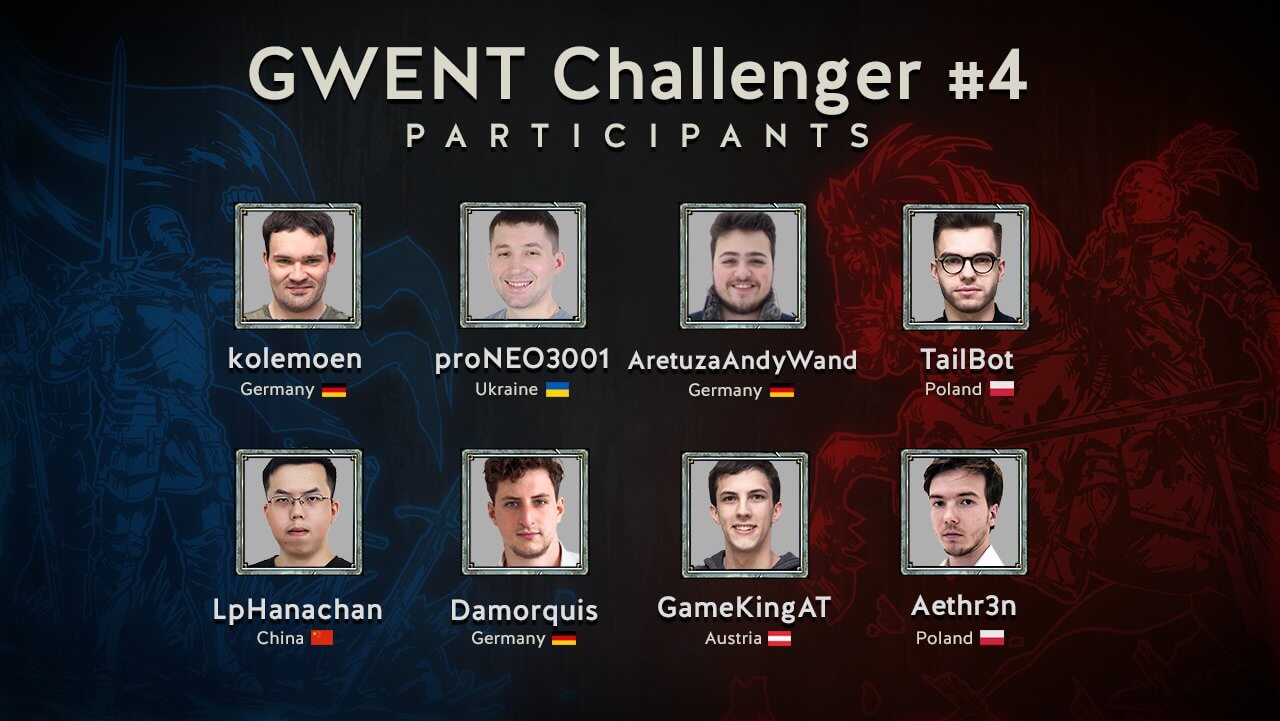
To understand what will have good chances to perform in the Challenger we needed to know what decks to expect from our opponents. Andy and I started off with trying to anticipate our opponent’s strategies in the tournament. Over the course of Gwent Masters events different types of preferences have emerged for deck choices.
LpHanachan: Known as a risk averse player, with a high preference for Dagon on blue coin and played King Foltest in Open #6 on red. He liked to play Greatswords and Alchemy, recently Shupe ST was a deck that he navigated to a high score.
Aethr3n: We worked with the assumption that a newcomer to tournament play may be more tempted than others to pick a targeting strategy. Aethr3n however achieved great success by winning the qualifier with non-targetable midrange decks like Crach an Craite Veterans, Tempo Jan Calveit, and King Foltest. His decision to bring midrange decks could have originated from others failed strategies to target Consume and Greatswords in the previous open.
Kolemoen: As one of the leading players in the world, Kolemoen is very confident in his skills. He often runs his favorite decks on stage, trusting in his ability to emerge victorious with them. As the world's best King Foltest player he would surely bring this deck. Also, he is well known for bringing consume, accepting the risk of counters despite having suffered the fate of being denied before.
GameKingAT: GameKing mainly played Crach an Craite Veterans on SK in past seasons, he won the Qualifier for Challenger by bringing Consume and beating even counter lineups on the way. Although he mostly played Nilfgaard Soldiers, shortly before challenger he switched to Alchemy on the ProLadder, which was an indication of him taking it to Challenger.
Tailbot: As one of the few players to play Spellatel on the ladder and in previous tournaments, Tailbot was hard to predict. He countered consume in Gwent Open #5 and Scoia'tael Ciri: Nova in Challenger #3, both times proceeding to the final. Therefore a soft targeting from Tailbot seemed not unlikely. What was also known of Tailbot is his high preference for Greatswords which he was also likely to bring.
ProNeo3001: Being known for his deckbuilding, ProNeo, just like Tailbot, was a hard one to predict. His high preference for soldiers over Alchemy is well known. Bringing King Foltest to the Open #6 proved beneficial, just like his idea to run Crach an Craite Veterans with Sihil for the first time. Three decks with strong preferences already sound less unpredictable however, ProNeo was playing hard Consume counters in the last days of Pro ladder which made Consume look less attractive as a pick.
Conditional Expectations
Although the points above reveal already a solid amount of information about the participants, preferences can never be analysed independently of the tournament meta. To form our set of conditional expectations we therefore needed to account for the prevalence of archetypes in the previous tournament and deck popularities on the pro ladder.
Several developments were taken into account to update the expectations on our opponents deck:
Rising popularity of King Foltest and the resulting decrease of popularity of Shupe Scoia’tel
Rising popularity of Crach an Craite Veterans
Appearance of Decks like Tempo Jan Calveit
Decreased popularity of control decks and hard counters to Consume
If we consider the players to have unique sets of preferences and a different willingness to update their tournament picks on the four conditions above, we can build a table including the most likely picks of each tournament participant. Of course, the picks we assumed are based on our own understanding of the player and have in some cases proved incorrect. This however is not relevant since the tournament meta as a whole will not stray too far away from the prediction and the conquest format doesn’t punish a wrong expectation too hard unless you get hard countered.
After our opponent analysis we came up with this expectation for the tournament meta:
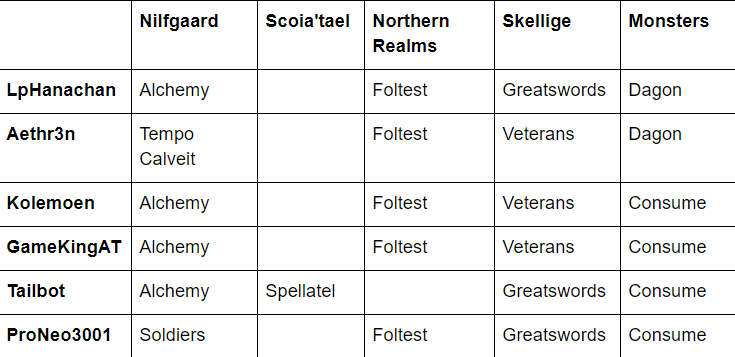
We didn’t expect Shupe ST, due to the popularity of King Foltest and Crach an Craite Veterans which both pose a big threat and could lead to a 0-3 on Shupe in a series really fast. Since King Foltest felt non-targetable and really strong in the recent days of the ProLadder we expected a lot of players to bring the deck. Same goes for Crach an Craite Veterans which performed great in the Pro Ladder season and also led ProNeo to the Open #6 finals.
Identifying weaknesses
Next we looked at our predictions and asked ourselves, which decks have similar power curves, weaknesses, and could be countered in a consistent way without major sacrifices.

King Foltest, Crach an Craite Veterans and Dagon all struggle versus so called “tall decks”, like Consume or Handbuff NG. Realising that King Foltest and Crach an Craite Veterans would be fairly popular, and Dagon was also in 1/3rd of the oppositions line-ups we decided to counter midrange decks in the tournament. Everyone who would pick a rather non-counterable, safe deck would be punished by our lineup.
An alternative road to go here is to realise that Consume is a very attractive pick for the Challenger. Already in the previous Open #6, Kolemoen, the winner, simply dodged the counters in his part of the bracket and his consume ended up as a “ban-magnet” for the opposition, who had no counters to the Solitair-Deck and was forced to take it out of the game. However we were unsure on the effect of the failure of Control last Open whether it would scare people of taking the same risk again or people would emphasize Kolemoen’s willingness to risk, which has been rewarded in the end. Having failed with the control approach in the last tournament we decided to take an alternate route this time.
Line-up building
Having identified the weakness we would like to utilise to our advantage the next question was what decks would most consistently beat the 3 targets, namely: Dagon Deathwish, King Foltest Temerians and Crach an Craite Veterans.
The first deck that we included in the lineup was Nilfgaard Handbuff.
With the rise of King Foltest (a great matchup), leading to the disappearance of Shupe ST (a bad matchup due to the multiple use of resets by mardroeme), the deck looked as tempting as ever to bring. Additionally, Crach an Craite Veterans (also a good matchup), have been preferred recently by numerous players to Greatswords which is a significantly harder matchup.
Next, we decided to bring consume to the tournament. Not only has Kolemoen’s willingness to risk been rewarded and control failed in the previous open, but also more midrange decks appeared on the scene, providing more good matchups for Arachas Queen. We expected it to be a ban-magnet again which was confirmed during the tournament later. Just like Handbuff, Consume is one of King Foltest’s worst matchups and also poses one of the worst matchups to Deathwish Dagon and Crach an Craite Veterans who have few tools to stop the Nekker train.
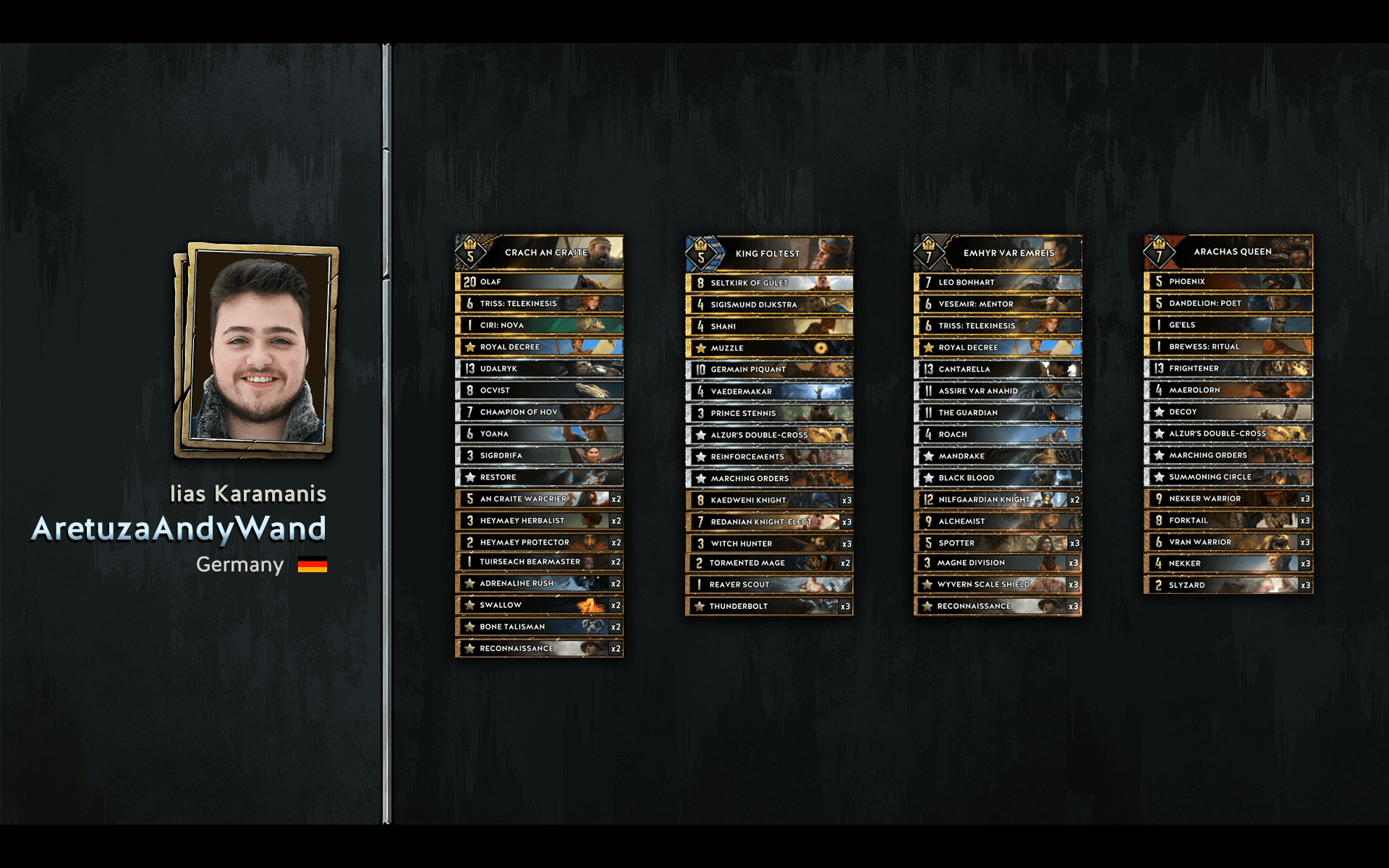
However, at this point it became harder to find decks that fulfill the criteria as sufficiently as Arachas Queen Consume and NG Handbuff. Quickly, we realized that there was no Scoia'tael deck that would suit our strategy, since Scoia’tel is in general weak to King Foltest. The popularity of Shupe ST in the first place was enough to increase the appearance of King Foltest in the meta, who was strongly favored against Shupe ST. Ultimately we gave up on Scoia'tael and looked elsewhere.
The idea to counter King Foltest and bring King Foltest ourselves sounded crazy and a bit hypocritical. That however, was exactly what we ended up doing in the end. We were aware that King Foltest mirrors are quite draw dependent and had to accept that risk. We were comfortable with doing that since all our decks were not purely designed to counter King Foltest only but also had several other favorable matchups. We decided not to run the Temerian package and designed our own version, giving us a slight advantage in the quarterfinal. We chose to run strong cards for the mirror like Redanian Knight-Elects, in order to generate passive value. Also Muzzle, to steal the opponents‘ Redanian Knight-Elect in a long round and generate a massive amount of points. The armor King Foltest list gave us an even more favorable matchup versus Dagon, which being typically played on blue coin was a likely matchup. Additionally the list had a good shot of outpowering Crach an Craite Veterans in a long round, giving little value to Sihil with armored units and generating points per turn, which the Crach an Craite deck lacks.
Greatswords seemed a solid pick for the last deck, beating Dagon Deathwish and Crach an Craite Veterans consistently. However, we also saw Tailbot almost get 2:0’ed by GameKingAT in exactly that matchup. We experimented with the deck but realised that the King Foltest match-up is not consistent at all. Seltkirk of Gulet, Vaedermakar, and Dethmold all were countering the deck in setting up the engines, and it was extremely hard to grab a win on blue from that point. In short: we didn’t believe in Greatswords on blue coin against King Foltest. We needed something different for Skellige. We tested different decks but in the end it was Swim and Crozyr who approached us on the Public Aretuza Discord with their An Craite Warcrier Olaf list. Sceptical at first, we tried it in the match-ups we were looking for and were surprised by the effect. The deck did exactly what we needed, however was extremely weak to decks like Greatswords, Alchemy, Control or Consume. We expected a lot of Consume but 1 bad match-up doesn’t matter since it is an easy ban. We practiced the match-ups against King Foltest , Dagon and Crach an Craite Veterans and were satisfied - we had found number four of our lineup. All of the decks above struggled to deal with the carryover and had no answer to tall units. Uncountered, the An Craite Warcrier Olaf list could reach extremely high values. We decided to take the risk, which was a moderate one, considering our predictions.
Practice
From this point on, the line-up was formed, the strategy was clear, and it came down to finding a good bracket while being well prepared for the games.
When preparing for the Challenger, first we played particular match-ups several times to extract the correct sequencing, find good passing spots, and understand how to play if nothing goes to plan. Mostly we practiced against Deathwish Dagon, King Foltest Foltest and Crach an Craite Veterans. Those were already favourable matchups, which is why we wanted to avoid at all costs to drop a game in this scenario. We distilled our win and lose conditions, like the Triss: Telekinesis taking Adrenaline Rush away in the Veterans vs Warcriers game, or passing too early against King Foltest and getting outnumbered by engines and weather and many more details.
After we felt comfortable with playing every matchup we anticipated, we decided to practice the tournament experience and played 10 best of 5s in a weekend, versus numerous players who have already proved their performance in Gwent tournaments like Adzikov, Freddybabes, MrMax71, Octopuses, kacper322, Santtu2x and many more! Playing against different player types helped us to get confident with the line-up and to experience different situations and reduce stress in the Challenger. While practicing we also played every series on blue coin, since we wanted to make to be confident on both sides of the coin. Overall we were happy with the results and sent in our lists.
Adjustments
Both AndyWand and I decided to run the same decks, which is why I decided to change 2 cards in my lists in the end. The first reason was that I believed that could give us an advantage if the opponent of whoever goes second from us assumes we have the same decks and misplays because of it. Secondly, I like the increased likelihood of finding Sigismund Dijkstra from The Last Wish over the tempo of Alzur's Double–Cross and the Decoy for an additional An Craite Warcrier boost or removal with Champion of Hov. A matter of preferences, which benefited Andy in his games vs Tailbot and made my series vs Kolemoen harder but on the other hand gave me an edge in the finals versus my teammate.
Tournament Tree
The amount of deck’s that we anticipated correctly was quite high, since most players stuck to their preferences and did not experiment or bring unusual decks to this Challenger.
The following table highlights the correctly anticipated decks during the preparation process. The uncolored fields show wrong calls, whereas the colored fields show where we anticipated correctly.
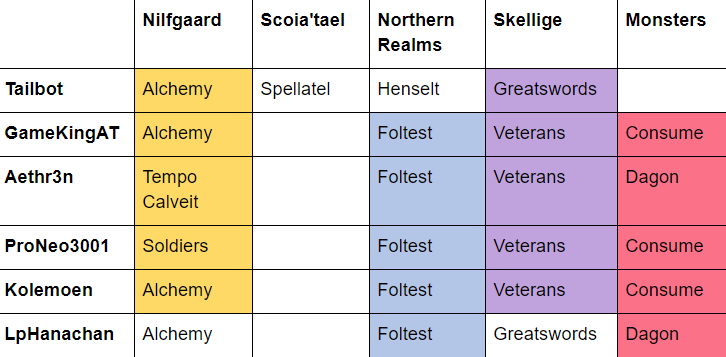
Looking at the table, the analysis of the competition paid off and it is possible, at least partially, to predict a tournament meta.
How good was the idea of targeting King Foltest, Deathwish Dagon and Crach an Craite Veterans? We can answer that by looking at the amount of favorable line-ups for our line-up in the next table.
Here we highlight all decks that are highly unfavored against the lineup that we brought, which we are very likely to win against with any of our four decks.
We are strongly favored if the opponent has 3 or 4 decks that we targeted or are favored against, favoured he brought 2 of those into the tournament and unfavored if it is only 1, unless it is King Foltest, which makes it a hard but even matchup, since our lists were the strongest against King Foltest. Remember here, that one of the unfavorable decks is being banned by us, which leads to this distribution.
Looking at the line-ups above, we had the following scenario:
Strongly favored vs Aethr3n and LpHanchan’s line-up
Favored vs Tailbot, GamekingAT, ProNeo3001and kolemoen
This distribution is exceptionally good for a tournament tree. The line-up was ideal and it performed very well during the games, allowing for dominant victories like AndyWand’s 3-0 against Tailbot or my 3-0 series against LpHanachan where our opponents had little to zero answers to tall units that were characteristic for all of our decks.
Ban Strategy
In the last chapter, let us look at the banning strategy of our lineup. As mentioned at the start of the article, control decks and decks with answers to tall units like Geralt: Igni, Mandrake, Scorch, Schirrú, etc. are very hard to beat with our line-up. Anticipating that the popularity of King Foltest would scare people from bringing Shupe Scoia'tael was a great call, but still some bad matchups found their way into the tournament. Let us investigate the table once more, here with the bad matchups being highlighted.
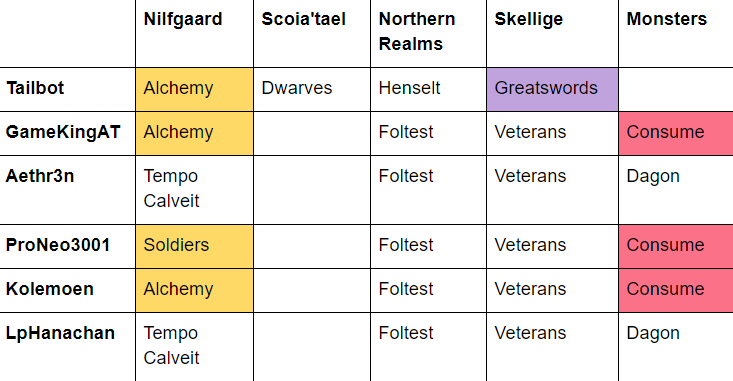
The little amount of bad matchups was very comforting. In particular, no player runs more than two dangerous decks and one always can be banned. In the semifinals between Kolemoen and I, many spectators were surprised to see Arachas Queen not being banned, as it had been in all the other series. Alchemy ended up receiving my ban. This is because I considered Alchemy and Consume equally bad matchups for my decks and I anticipated the one I would not ban on blue against my King Foltest on red. So, I decided to let Consume through for the only time in the tournament. Consume is slightly less consistent than Alchemy and additionally can always lose to not drawing, Nekkers, or Nekker Warriors.
The Muzzle in my King Foltest would enable me to sneak a victory in case only 1 nekker was accessible by Kolemoen and in case of good draws the use of resets from Witch Hunters could put Kolemoen in trouble. Unfortunately, I did not find the cards I hoped for in the match and was beaten in a dominant fashion. However, that was always a scenario likely to happen and as said before, having one bad match-up and two good ones still holds great chances for a victory in the overall series. I would have not had an easier time with my King Foltest against Alchemy whose Viper Witchers would have done quick work of my Redanian Knight-Elects and punished my draw dependent King Foltest even harder with the use of Assire var Anahid.
The usual ban however was Nilfgaard due to its control abilities, Consume, due to our non existent control and greatswords since it is a deck whose engines uncontested can outpower even greedy lists.
Credits
We would like to give a big shoutout to our preparation team with Gwent2Town, Gvuardya, Adzikov, Molegion, Crozyr, and Octopuses for the theorycrafting, practice and analysis that made our success possible! And of course to everone who scrimed with us and helped us to improve our gameplay in practice matches or best of 5’s!
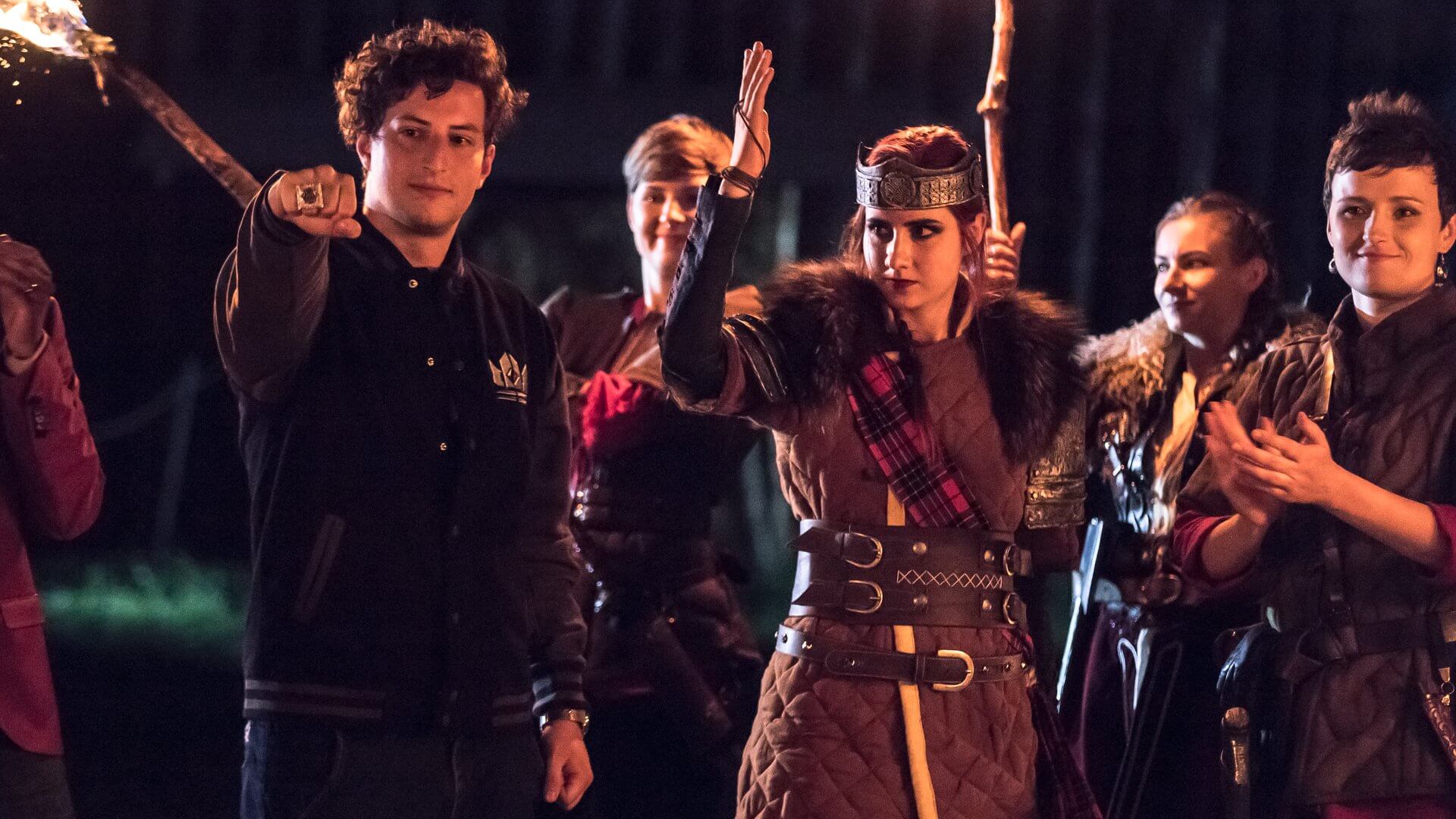

Author
Damorquis
Damorquis qualified for three consecutive Gwent Opens and holds the title of Gwent Challenger #4 champion and Challenger #5 runner up. His passion for The Witcher universe and his real-life knowledge of behavioral economics helped him develop Team Aretuza, the strongest Gwent esports team in the world. Currently he focuses a career in management consulting and will compete in Gwent's biggest tournament so far Gwent Masters in 2021. His extensive tournament preparation often results in ambitious, innovative decks that catch even the best opponents by surprise, and his highly disciplined approach to gaming, always looking for mistakes and areas to improve, provides his unique edge against the competition.




